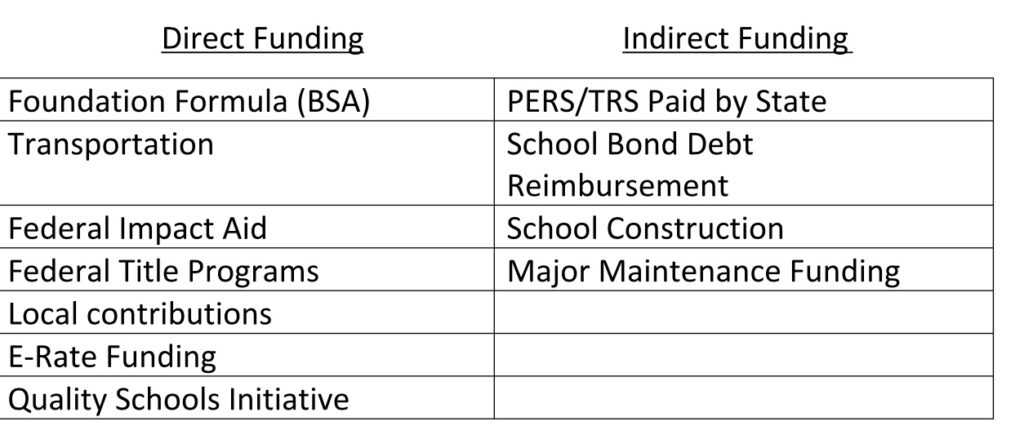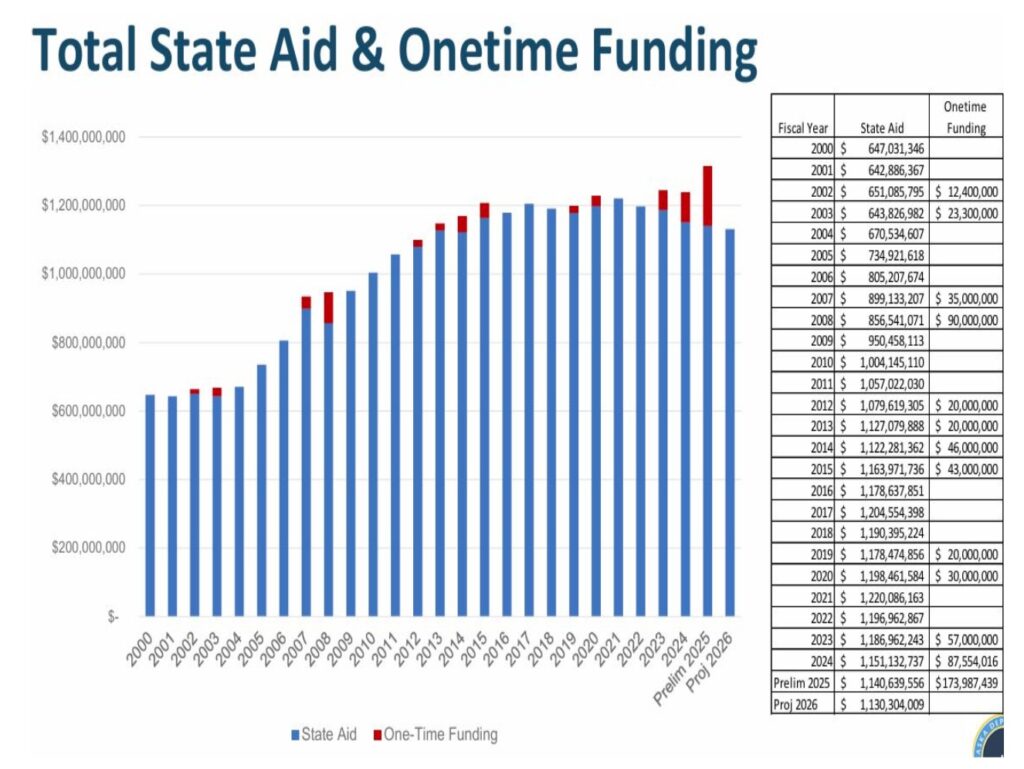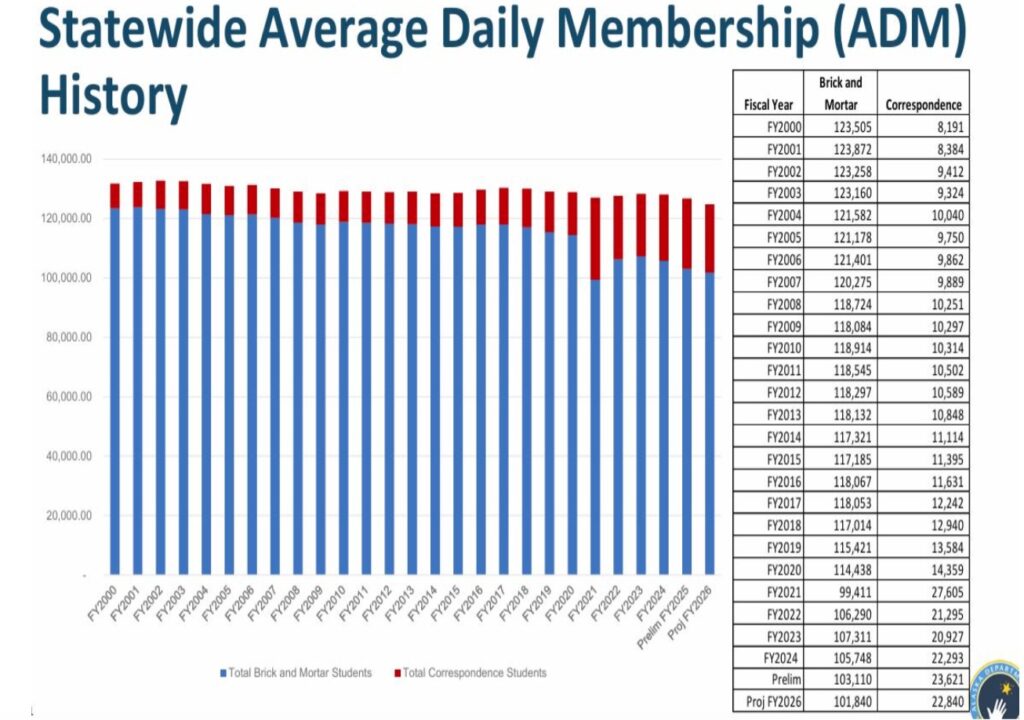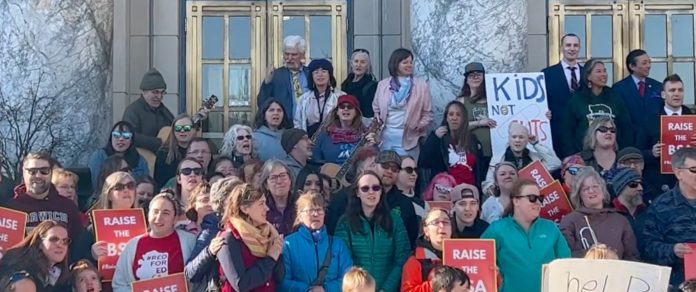By DAVID BOYLE
The Alaska Legislature is again wrestling with increasing the funding of our K-12 education system. The mantra of “flat funding for decades” has been replaced by “inflation is causing the system to fail.”
The supporters of more funding — with no accountability for results — focus on a single funding factor, the Base Student Allocation, or BSA. They ignore the additional revenue streams that also fund our education system.
This misleads the Legislature and the public. In truth, the Legislative Finance Division says that funding for K-12 has increased by 34% since 2006.
Here are the funding streams that pay for our K12 system:

The FY24 State aid to school districts consisted of $1,151,132,737 (based on the Base Student Allocation funding formula). Pupil transportation for FY24 was nearly $71 million, which is in addition to the BSA formula. Note that for FY25 an additional $7.3 million was provided outside the transportation funding formula for a declining number of students.
In FY24 the federal government provided $88,768,627 in impact aid. This funding comes from nontaxable federal properties as an offset to local tax dollars.
In FY24 the Alaska Legislature provided one-time funding of $87,554,016 outside the BSA formula. Another added revenue stream comes from “minimum required local effort” which requires organized boroughs to kick in a “fair share” to pay for the local schools. For FY24 this totaled $300,641,017 from schools in organized boroughs and municipalities.
The E-Rate funding comes from federal funds that every cell and landline user pays for. This used to be called the Universal Services Fund. In FY23 the state received more than $100 Million in E-Rate funds. These funds go to most of the rural schools to pay for the internet and communications. Here is a listing of the schools that received these funds:
The Quality Schools Initiative provides an additional $16 per student count. In FY24 this totaled $4.1 million. The state received more than $257 million from the various federal title programs in FY23.
Here is a Department of Education graph showing total State aid and one-time funding through time:

During the Covid “pandemic,” the State of Alaska received an additional $579,826,453 in federal funding through various legislation. Some of this funding was limited in its use. The question is, “What did all this money do to improve student achievement?”
To its credit, the Department of Education has provided transparency in the allocation and use of these Covid funds (link may not work in Safari browser, but works in Chrome): https://app.smartsheet.com/b/publish?EQBCT=0cfd777df5b94c0bbec2 7cc0631318a4
The education industry sees the writing on the wall: The number of students is seriously declining and because the state’s funding is based on that number it wants to inflate the funding to the maximum. State aid is projected to decrease another $36 million due to the decrease in student enrollment.
Since 2014 the number of brick-and-mortar students has decreased by 11,573. And the number of correspondence students during that same period has gone from 11,114 to 22,293.
This is an astounding increase of 11,179 students. Here is a graph from DEED showing the data from FY2000 through a projected student count for FY2026:

We need accountability for results rather than throwing money at the problem. Incentivizing current bad behavior will only result in the education industry returning to the legislature and asking for even more funding.
I say the Legislature needs to ensure the funds go to the classroom.
But what do you think? Are we spending enough? Or do we need to spend more without accountability for results?
You can provide your testimony on HB 69 by writing to [email protected]
David Boyle is the education writer at Must Read Alaska.

Oh please! Schools are failed institutions because the teachers earn the same regardless of whether or not the students learn anything at all.
It’s called a salary
Negotiated agreement. Just like McDonald whether there is a lunch rush or not.
Time to follow Trumps lead and clean out dead end 40 hour a week squatters from education.
Ha. Most work 60 a week.
The usual Democrat mantra, “give us more money and everything will be okay.” One of the glaring issues is the students themselves. There is no one accountable for their actions. Try to kick out an unruly student and some cousin, aunt, uncle will show up screaming and threatening to sue. Add to this DEI and it’s a perfect storm for a sh_t show, which our schools have become.
Gross ridiculousness. The public school system as it is, is an albatross. First, get rid of the federal department of education (department of social engineering). States should be in charge. Next, allow for and encourage school choice, competition , incentives, parent involvement, tax credits to parents for private education, more home schooling. Do not protect teachers who should not be teaching. Get rid of them and allow them to find a more suitable career.
Using the Department of Education’s figures is RICH! Keep it up Boyle… you’ll soon be a wort!
SalmonSupper, What’s your problem with actual data from the Department? Or would you rather use data form the NEA/AFT? Note I also use data from Legislative Finance. The question should be, “Is the data valid?” What data source would you use? Thanks for listening.
Bad teachers and politically motivated administrators are why the schools are failing.
Only in education can one do a poor job for years and demand more money
And the poorer they perform the more money they demand. Rinse and repeat.
Not you too. I thought better.
Just stop you weren’t even a teacher.
Look up my license.
Oh goody we have a substitute teacher pretending to be a well rounded, highly educated, comment section jester.
I don’t have a sub license. It’s a class C.
My bad
It is or was a type M. Might be expired by now….
It has been 5 years after all
Might still be on the books.
I just looked it up. It expired in 2023 but it’s still on the books. Go to alaska teacher certification license look up and you shall find it, sonny boy.
You know there are a lot of really good teachers in our public school system. But they have to work in a system where kids aren’t held back if they don’t perform, they have a prescribed curiculum that may not work, and they are dealing with children from a disfunctional situation who show up hungry and unsupported at home. So they are teaching to the lowest common denominator and losing the interest of the rest of the students. There are no easy solutions here. School choice is definitely a start, but solving the homelife and mentorship problem is going to take some very hard times I am afraid.
Well put
Also, there’s a push to keep kids eligible for sports. In the bush, basketball, maybe the only reason they’re attending school.
EXACTLY! You are correct on every aspect. Money will not help this and a complete overhaul of the educational system needs to happen. We need to do year round schooling like they do in Europe. Parents need to be held accountable and penalties applied to help them get through school. The curriculum needs to be changed back to the ones we did it the 70 & 80s. Vocational schools need to be brought back and encouraged as much as colleges. Basics need to be done in elementary before they go to secondary.
We have four teachers in our family and they’re all telling the same thing. It’s the administration that’s taking the money laying down the rules and being the problem.
The teachers can’t touch or say the wrong thing to a kid in class or they wind up getting fired.
They have all kinds of problem, kids that wanna act up kids don’t wanna burn in the classroom and no help from the administration.
The administration needs to cut 50 to 60% of their overhead. Why do we need multiple the principles at schools?
Clean house and get rid of administration before you come crawling for more money.
That is an excellent assessment of the problem, the district in Anchorage is a top heavy, disjointed mess.
President Trump mentioned previously that school choice must occur in time for the 25-26 school year, which for most homeschool families, or families confirming public or private sectors with their enrollment, needs to occur by July 1st, 2025. Considering how quickly Trump is cleaning up our government, this is totally feasible… knowing previous Alaskan bureaucracy in the education sector, that is a different story. Our family would like to see an article published on when School Choice will really begin for Alaskan families. We would also like to see how the Administration and State of Alaska in particular plans to hold public sector, private sector and homeschool programs equally accountable, in terms of their spending, their curriculum and their outcomes. We’ve never understood why a public school teacher can, as an example have donuts reimbursed through the district and yet an Abeka chapter book is not reimbursable through any homeschool program. There are significant disparities between what is allowed and considered acceptable even between homeschool programs, one program offers an allotment of this, while another offers half of that. Programs continually chalk this numerical disparity up to services provided and costs associated with that program, but the reality remains quite different. Whether a child is enrolled in a neighborhood public school, a religious private school or a community homeschool program, each student allotment should be the same.
Only a tall Oosik would believe teaching 26 kids at once instead of 22 kids at once is a good way to improve test scores
Lol. Alaskan fake Republican math.
Is that why alaska schools were in the top 10 nationally in 80’s? Class sizes were comparable to what you claim. What is the common denominator? The change in teachers and over abundance of excess administration and staff.
In the 60s and 70s we had classes with up to 33 kids in them in my schools. Our test scores were pretty damn good, but we didn’t concentrate on all the social BS in the classroom, we actually concentrated on the subjects and facts.
It’s time to call a spade a spade. The public education system in the United States has devolved into a government work program for low achieving adults. A disillusioned schoolteacher told me that over 30 years ago and sadly he was spot on!
Look into the real reasons for the Great Depression, much of it was associated with the lack of education during that time (in what we know to be normal/formative school years) and how that effected the entire nation. Not a conspiracy… Untold history of the US.
This data is critical. The comments resemble my conversations with teachers and parents. While ASD’s budget shows a reduction in administration costs, they also admit definitions were changed by DEED. Something isn’t adding up and the results are right under our noses. David Boyle’s testimony in the house committee noted some great solutions. I’ll add roth403b to replace pensions for staff as they are more affordable to run with better outcomes for employees. Necessity is the mother of invention. It’s time to remake education here at home.
There are so many good suggestions here to improve education without pouring additional money down the rat hole. Make the kids and their parents more responsible for results, quit teaching social garbage, and get back to teaching the basics that will help the student succeed in adult life. Evaluate and eliminate excess administrative positions, award teachers who are innovative, and let the teachers teach real classes. Let the parents who want to get involved help out with their kids instead of forcing social garbage on the kids and locking out their parents. Also, let’s let the parents have the choices they need to educate their kids. Many times, public schools might not be convenient for the student, so there has to be alternatives like home-schooling that is taught to a certain standard and also charter schools. We should not be afraid to see alternatives. And if the kid needs counseling, teachers should be able to speak up, not told to keep their mouths shut. Most of this can be done at the local level. So let’s get started.